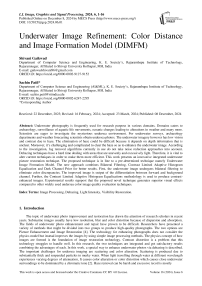Underwater Image Refinement: Color Distance and Image Formation Model (DIMFM)
Автор: Shivani Gaikwad, Sachin Patil
Журнал: International Journal of Image, Graphics and Signal Processing @ijigsp
Статья в выпуске: 6 vol.16, 2024 года.
Бесплатный доступ
Underwater photography is frequently used for research purpose in various domains. Domains caters to archaeology, surveillance of aquatic life movements, oceanic changes leading to alterations in weather and many more. Scientists are eager to investigate the mysterious undersea environment. For underwater surveys, archaeology departments and weather forecasting scientists obtain undersea photos. The underwater imagery however has low vision and contrast due to haze. The elimination of haze could be difficult because it depends on depth information that is unclear. Moreover, it’s challenging and complicated to clear the haze so as to enhance the underwater image. According to the investigation, fog removal algorithms currently in use do not take noise reduction approaches into account. Dehazing techniques have a hard time dealing with areas that are unevenly and excessively light. Therefore, it is vital to alter current techniques in order to make them more efficient. This work presents an innovative integrated underwater picture restoration technique. The proposed technique is in line to a pre-determined technique namely Underwater Image Formation Model. The new approach combines Bilateral Filtering, Contrast Limited Adaptive Histogram Equalization and Dark Channel Prior for better results. First, the underwater image undergoes bilateral filtering to eliminate color discrepancies. The improved image is output of the differentiation between forward and background channel. Further, the Contrast Limited Adaptive Histogram Equalizations methodology is used to produce contrast-enhanced images. Experimental results signpost that the proposed novel technique generates superior visual effects compared to other widely used undersea color image quality evaluation techniques.
Image Processing, Dehazing, Light Intensity, Visibility Restoration
Короткий адрес: https://sciup.org/15019564
IDR: 15019564 | DOI: 10.5815/ijigsp.2024.06.01
Список литературы Underwater Image Refinement: Color Distance and Image Formation Model (DIMFM)
- Y.Y. Schechner and N. Karpel “Recovery of underwater visibility and structure by polarization analysis.” IEEE Journal of Oceanic Engineering, 30,no. 3,pp.570–587,2005.
- K. Iqbal, R. Abdul Salam, M. Osman & A. Z. Talib “Underwater Image Enhancement Using An Integrated Color Model.” IAENG International Journal of Computer Science,32, no.2, pp.239-244, 2007.
- H.Y. Yang, P.Y. Chen, C.C. Huang, Y.Z. Zhuang & H.Y. Shiau "Low complexity underwater image enhancement based on dark channel prior." IEEE Second International Conference on Innovations in Bio- inspired Computing andApplications,pp.17-20,2011.
- A.T. Çelebi& S. Ertürk “Visual enhancement of underwater images using Empirical Mode Decomposition.” Expert Systems with Applications (Elsevier), 39, no.1, pp. 800-805,2012.
- J. Y. Chiangand Y.C. Chen." Under water image enhancement by wavelength compensation and dehazing." IEEE Transactions on Image Processing, 21, no. 4, pp. 1756-1769, 2012.
- H. Wen, Y. Tian, T. Huang, & W. Gao "Single underwater image enhancement with anew optical model." In IEEE International Symposium on Circuits and Systems, pp. 753-756, 2013.
- L. Chao and M. Wang, ‘‘Removal of water scattering,’’ in Proc. IEEE ICCET, Apr. 2010.
- J. Y. Chiang and Y.-C. Chen, ‘‘Underwater image enhancement by wavelength compensation and dehazing,’’ IEEE Trans. Image Process., Apr. 2012.
- P. Drews, Jr., E. do Nascimento, F. Moraes, S. Botelho, and M. Campos, ‘‘Transmission estimation in underwater single images,’’ in Proc. IEEE ICCVW, Dec. 2013, pp. 825–830.
- D. Berman, T. Treibitz, and S. Avidan, ‘‘Diving into haze-lines: Color restoration of underwater images,’’ in Proc. BMVC, vol. 2017, pp. 44.1–44.12.
- Y. Wang, H. Liu, and L.-P. Chau, ‘‘Single underwater image restoration using adaptive attenuation-curve prior,’’ IEEE Trans. Circuits Syst. I, Reg. Papers, vol. 65, no. 3, pp. 992–1002, Mar. 2018.
- J.-H. Kim, W.-D. Jang, J.-Y. Sim, and C.-S. Kim, ‘‘Optimized contrast enhancement for real-time image and video dehazing,’’ J. Vis. Commun. Image Represent., vol. 24, no. 3, pp. 410–425, Apr. 2013.
- R. Achanta, A. Shaji, K. Smith, A. Lucchi, P. Fua, and S. Süsstrunk, ‘‘SLIC super pixels compared to State-of-the-Art super pixel methods,’’ IEEE Trans. Pattern Anal. Mach. Intell., vol. 34, no. 11, pp. 2274–2282, Nov. 2012.
- K. He, J. Sun, and X. Tang, ‘‘Guided image filtering,’’ IEEE Trans. Pattern Anal. Mach. Intell., vol. 35, no. 6, pp. 1397–1409, Jun. 2013.
- Y. T. Peng and P. C. Cosman, “Underwater Image Restoration Based on Image Blurriness and Light Absorption,” IEEE Trans. Image Process., vol. 26, no. 4, pp. 1579–1594, Apr. 2017.
- H.-H. Chang, C.-Y. Cheng, and C.-C. Sung, ‘‘Single underwater image restoration based on depth estimation and transmission compensation,’’ IEEE J. Ocean. Eng., vol. 44, no. 4, pp. 1130–1149, Oct. 2019.
- Bubble Vision. Accessed: Jul. 2020. [Online]. Available: https://www. youtube.com/user/bubble vision.
- Y. Li, J.-B. Huang, N. Ahuja, and M.-H. Yang, “Deep joint image filtering,” in Proceedings of the European Conference on Computer Vision, 2016, pp. 154–169.
- E. Park and J. Sim, “Underwater Image Restoration Using Geodesic Color Distance and Complete Image Formation Model” in IEEE Access, 2020, pp. 157918-157930.


